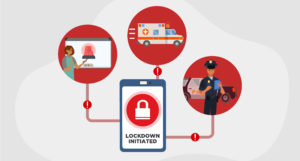Listen to this blog
4 minutes
Building a school safety culture is a critical aspect of school safety and security—but encouraging students to report concerns is no easy task. Barriers to student reporting include a lack of trust—in adults as well as in the process—and uncertainty surrounding whether their concerns are worth reporting at all.
The RAND Corporation released the findings in 2022 from their analysis of threat reporting for school safety. To perform their analysis, they drew on existing literature on threat reporting and leveraged knowledge gained from a series of interviews with state-, district-, and school-level stakeholders from across the country.
About the Rand Corporation: The RAND Corporation is a nonprofit institution that helps improve policy and decision making through research and analysis. RAND reports present research findings and objective analysis that address the challenges facing the public and private sectors. All RAND reports undergo rigorous peer review to ensure high standards for research quality and objectivity.
Based on their recent analysis, they shared the following best practices for encouraging students to report threats.
Their analysis suggests the following 7 best practices are key to improving student willingness to report potential threats:
1. Build Strong Relationships
It’s no surprise that relationships are key. Educators already lean on their rapport for helping students overcome obstacles and grow into their best selves. But the RAND analysis indicates another benefit to building those strong relationships: improved student threat reporting.
Trusting school climates in which students feel comfortable going to an adult with their concerns are the foundation of productive approaches to reporting… This can be especially important in contexts with low levels of community trust in police. ~ “Conclusions and Implications for the K–12 School Community,” Supporting Threat Reporting to Strengthen School Safety, RAND Corporation
Building that rapport takes time, but there are steps you can take to facilitate growth. Identifying and responding to students’ mental health needs, for example, can help students feel supported in their school community.
2. Emphasize accessibility and communication capabilities
Overcoming the social stigma around threat reporting is particularly difficult for students—so communicating those concerns needs to be as simple and accessible as possible.
Approaches to reporting are likelier to support all members of the reporting community, including students, if they emphasize accessibility and cater to common ways in which today’s student population communicates. “Conclusions and Implications for the K–12 School Community,” Supporting Threat Reporting to Strengthen School Safety, RAND Corporation
Making remote reporting options—such as a toll-free phone number, web portal, or mobile device application—available in addition to in-person reporting directly to a teacher or other trusted adult will greatly strengthen the likelihood of student threat reporting.
3. Anonymity helps more than it hurts
Speaking of overcoming the social stigma, offering anonymous reporting options improves student willingness, as well. Have a policy in place to determine if anonymous reporting options will collect no reporter data at all, or if that information will simply be kept private—and be transparent with that policy. More on transparency in number 6.
An anonymous reporting option can help address student fears of being ostracized by their peers as a result of reporting. Although anonymity poses some complications in following up on tips, stakeholders in the K–12 community across the United States agree that the benefits far outweigh the costs. “Conclusions and Implications for the K–12 School Community,” Supporting Threat Reporting to Strengthen School Safety, RAND Corporation
4. Provide crisis communication support
Having crisis counselors available as tipline responders will enable you to provide immediate support to students in crisis, including those reporting suicidal ideation or self-harm. Having trained counselors present can also help reduce the perception that the tipline is connected with law enforcement, which can help to increase the likelihood of students reaching out.
Reporting programs with the option to speak or chat directly with someone trained in crisis communication provide additional support and can lower barriers to reporting for those not comfortable speaking directly with law enforcement. “Conclusions and Implications for the K–12 School Community,” Supporting Threat Reporting to Strengthen School Safety, RAND Corporation
5. Offer training and build awareness
Uncertainty and self-doubt are significant obstacles to student threat reporting. Help students overcome these obstacles by regularly teaching them not only what to report, but how and to whom. Familiarity with the process will encourage its use.
Building awareness and implementing training on the importance of reporting and how students can report information are critical to supporting people seeking to come forward. “Conclusions and Implications for the K–12 School Community,” Supporting Threat Reporting to Strengthen School Safety, RAND Corporation
Consider the following suggestions:
- Provide regular training and outreach;
- Offer prerecorded training, but also tailor those materials to specific school contexts and scenarios. It will resonate more strongly if the trainings reflect experiences they are currently having;
- Share short, relatable examples that illustrate circumstances worthy of reporting;
- Include student leaders in training and outreach to help lower barriers among their more-reluctant peers.
6. Be transparent
Maintaining transparency is good practice when building trust in any relationship, and that is true with students as well as adults.
Transparency in and communication of how schools act on information reported through a tip line or via other methods influence students’ willingness to come forward. “Conclusions and Implications for the K–12 School Community,” Supporting Threat Reporting to Strengthen School Safety, RAND Corporation
Include a page on your website where you can post regular reports as well as details pertaining to district policy, such as thresholds for involving law enforcement. Make insight into your threat reporting process freely available—and make sure your procedural practice and policies align.
7. Encourage staff buy-in, too
Encouraging students to trust in the threat reporting system becomes significantly easier when the adults they trust believe in it—so have input and buy-in from the relevant adults.
Gaining buy-in from school leadership, teachers, and other school staff increases the chances that a reporting program will be effective and sustainable. “Conclusions and Implications for the K–12 School Community,” Supporting Threat Reporting to Strengthen School Safety, RAND Corporation
School safety is a journey, not a destination
Building confidence and an atmosphere of vigilance is key to strengthening your school’s safety and security. Having measures in place to better identify and document concerns will empower your school to better protect its students.
Raptor’s patented StudentSafe™ technology brings together the systems that help schools recognize, document, support, and manage the wellbeing of individual students. Staff is empowered to catalog low-level concerns for early intervention and, when necessary, qualified personnel can escalate a case to a behavioral threat assessment (BTA). Robust student chronologies and case management tools help staff guide students to a safer path.
Learn more about how Raptor can help strengthen your school’s safety and security.
Related Resources
A Raptor Guide: Bridging the Gap Between Schools and Public Safety
Collaborating with public safety improves school emergency preparation, response, and recovery.
Listen to this blog
4 minutes







